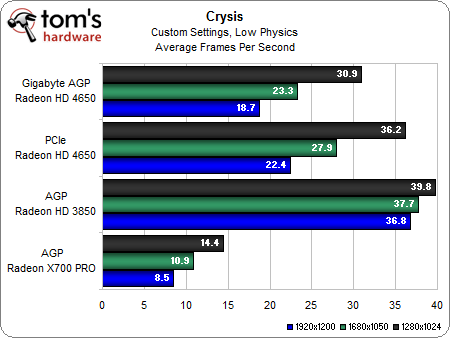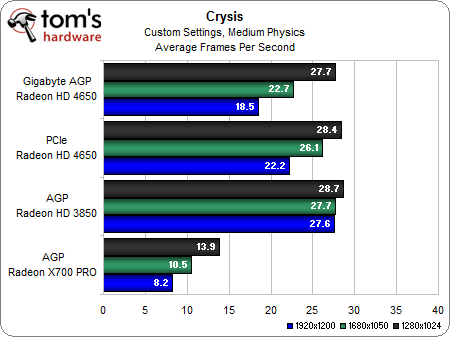Gigabyte's Radeon HD 4650: Are AGP Graphics Still Good Enough?
Benchmark Results: Crysis
We'll start the benchmarks off with one of the toughest games out there: Crysis. Since we're out to get playable frame rates, we can't go all-out with the settings. But we want the game to look good. So, while we chose Low settings to start, we upped the next round of results to include Medium quality textures, shadows, shaders, water, and sound. In Crysis, the most important settings for eye candy are shaders and shadows, so we went beyond that a bit. Let's see what happened.
Right out of the gate, we're seeing some interesting data. Apparently, the PCIe bus' additional throughput enables quantifiable performance gains, even with a mainstream card like the Radeon HD 4650, as as the PCIe Radeon HD 4650 is quite a bit faster than its AGP counterpart.
But look at how the older Radeon HD 3850 easily surpasses the other, more modern, contenders. This can only be attributable to the card's memory bandwidth advantage, with fast GDDR3 and a 256-bit memory bus compared to the Radeon HD 4650's 128-bit bus and slower DDR2. Note how the Radeon HD 3850 is bumping into what appears to be a CPU bottleneck at about 40 frames per second (FPS).
There is not much to see from the Radeon X700 unfortunately, as it isn't even able to deliver playable frame rates at 1280x1024 with settings turned down to Low.
At this point, it looks like the Radeon HD 3850 will remain the king of AGP, delivering essentially the same performance from 1280x1024 all the way up to 1920x1200. The Radeon HD 4650s are on the edge of playable at 1280x1024, but not at higher resolutions. This isn't as bad as it sounds because these cards are going into older computers, and a 1280x1024 resolution is probably typical of the displays these cards will be driving.
Let's stress the CPU a little bit more with the medium physics setting, which allows for smashing up in-game buildings.
Here is where we see the CPU bottleneck put an end to any dreams of lightning-fast gaming on our old Athlon X2 3800+ machine. The CPU's maximum capabilities have moved peak performance down to about 29 FPS, which will likely be considered unacceptable by most. In our opinion, the physics setting should be left at Low on older machines.
Get Tom's Hardware's best news and in-depth reviews, straight to your inbox.
Current page: Benchmark Results: Crysis
Prev Page Test Settings And Benchmarks Next Page Benchmark Results: Left 4 DeadDon Woligroski was a former senior hardware editor for Tom's Hardware. He has covered a wide range of PC hardware topics, including CPUs, GPUs, system building, and emerging technologies.
-
drealar *Raise up hand*Reply
I'm still using an AGP HD 2600XT :D.
Good to see that Gigabyte and actually Sapphire too coming up with another card for AGP. But frankly, we (most AGP users in my neighborhood ) are keeping our dollars for now since upgrading to a new system is the most likely option in 2010.
Another thing is, from the benchmarks, it got me worried if I ever upgrade my GPU since most of the result shows CPU bottleneck. If these are the result for a dual core Athlon, then it must be worse for my single core P4 HT :(
Oh BTW, are you reading the power consumption correctly?
"Even the Radeon HD 3850 and its GDDR3 memory peak at a mere 7 W more than the PCIe Radeon HD 4650 under load."
194 - 178 = 16W. So either the graph is wrong or you mis calculated. -
zinabas amdfangirlDon't they have an AGP HD 4670?Reply
a quick search for "agp 4670" on newegg gave me and (Core clock: 750 mhz, 1gb ddr3)
I own a pcie version of it and I really think before part 2 of this article goes up you should acquire one. -
rambo117 amdfangirlDon't they have an AGP HD 4670?Reply
yah, i just saw that on the egg today. Must have just come out.
i liked the article btw. ouch at the performance numbers though xD -
zinabas http://www.newegg.com/Product/Product.aspx?Item=N82E16814161284Reply
http://www.newegg.com/Product/Product.aspx?Item=N82E16814131161
links aren't working -
rambo117 yah, this is the one i saw: http://www.newegg.com/Product/Product.aspx?Item=N82E16814161284Reply
looks pretty nifty. iceq FTW! -
eddieroolz AGP is like Windows XP, it just never dies :DReply
Anyways, it's interesting to read something about legacy ports for a change. I never even figured out how to work with computer hardware when AGP was around, so I never got to mess around with it. -
one-shot Most of these benchmarks seem to show a CPU limitation across the board. I owned that same CPU, but used a PCI-E 7900GS with it at the time. I think if the CPU limitation was eliminated, we would see a better overall comparison. Also, if there is an AGP 4670, it would be beneficial to older machines to see the benefits of that GPU. It might show the two cards being equal due to the CPU limitation we're encountering.Reply -
masterjaw I don't think there are lots of people out there who would still hold on to their AGP slots when PCI-e cards are becoming so cheaper and the performance is way better. Even doing a low-end system upgrade would still kick older system's ass all the way to the north pole. But still, another option for those who can't get over the AGPs. They must've been clearing up some old stocks.Reply

